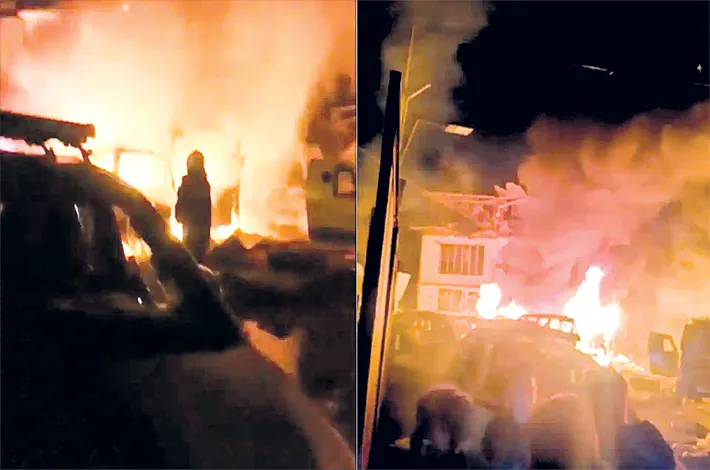Deadly chemistry vs fatal negligence?
18-11-2025 12:00:00 AM

What could have triggered the explosion? With unstable ammonium nitrate surrounded by flammable and reactive materials, any of the following could have been enough:
■ A small spark from a circuit or battery.
■ Friction from moving metal containers.
■ Moisture entering phosphorus or potash packets.
■ Static electricity from winter clothing.
■ Heat generated during handling.
■ Contamination of ammonium nitrate by organic material such as paper, cloth, or oil.
The explosion at the Nowgam police station on the night of November 14 was far from ordinary. It wasn’t just an accident—it was a catastrophic chemical event that transformed the entire facility into a lethal blast zone. Nine people died instantly, and twenty-nine others were injured. The force of the blast shattered windows kilometers away, with tremors felt even 30 kilometers from the site. How did a police station, meant to be a place of law and order, become ground zero of one of Kashmir’s deadliest non-terror explosions in recent memory?
The answer lies in what was stored inside the station. Nearly 2,900 kilograms of explosive materials were kept openly, without proper segregation or safety measures. This wasn’t just evidence—it was a chemical time bomb waiting to go off. Among the most dangerous was ammonium nitrate, over 350 kilograms of which were stored at the station. To the untrained eye, it resembles ordinary fertilizer. In controlled environments, it is harmless. But history shows its lethal potential: it caused the devastating 2020 Beirut port blast, contributed to the 1995 Oklahoma City bombing, and has been repeatedly used by terrorist organisations worldwide for improvised explosives.
Ammonium nitrate is chemically stable under the right conditions, but under contamination, heat, confinement, or when mixed with incompatible chemicals, it decomposes violently. Its chemical formula, NH₄NO₃, breaks down to release nitrogen gas, oxygen, and water vapor at a speed that produces devastating shockwaves capable of collapsing buildings and killing anyone nearby.
In Nowgam, conditions were far worse than unsafe—they were deadly. The ammonium nitrate was stored alongside phosphorus, potash, metal sheets, batteries, wires, remote controls, and highly flammable materials. Each item alone posed a risk, but together they formed a perfect storm of reactive chemistry. White phosphorus can ignite spontaneously in air and burns at extremely high temperatures. Potash reacts with moisture or friction. Circuits and batteries can produce sparks. Flammable substances accelerate combustion. The combination was a ticking time bomb, waiting for the slightest trigger.
The Jammu and Kashmir Director General of Police, Nalin Prabhat, described the explosives as “unstable.” In chemistry, stability means predictability. Unstable explosives are unpredictable and can detonate with heat, shock, friction, contamination, or even spontaneously. Storing such materials casually, in open spaces, is equivalent to placing a live grenade in a crowded room.
The victims of this chemical catastrophe were ordinary officers and staff performing their duties. Among the dead were a State Investigation Agency member, three forensic experts, two police photographers, two revenue officials, and a tailor assisting the team. The injured included 27 police personnel, two revenue officials, and three civilians from nearby homes. None of them could have imagined that a routine inspection would turn into a lethal chemical incident.
The blast occurred during standard evidence-handling procedures. A magistrate-led team had arrived to collect samples of the seized explosives, following legal protocol. Yet, opening and examining the containers likely triggered a chain reaction. Ammonium nitrate does not always require a detonator; if contaminated with even minor organic material—paper, cloth, or oil—it can explode from a minor stimulus such as friction, heat, or impact. If white phosphorus was present, it could have ignited spontaneously, providing the initial fire to set off the explosive stockpile.
But the critical question is not the trigger—it is the storage. How could nearly three tons of explosive chemicals be kept in the open courtyard of a police station? Why were they not moved immediately to a controlled facility? Who authorised such dangerous arrangements, and how did multiple layers of supervision fail to prevent it? The oversight was not just negligence—it was systemic.
The explosives were part of a significant counter-terror operation targeting a Jaish-e-Mohammad module. Three doctors from Faridabad and Saharanpur had been arrested, while a fourth accused, Umar Nabi, remains at large. The seizure was a critical success in preventing a potential terror attack. Yet, in attempting to safeguard the public, authorities inadvertently created conditions for a disaster of comparable magnitude.
Standard procedure for handling large quantities of explosive materials is clear. They must be transferred immediately to secure ammunition depots or Explosive Ordnance Disposal (EOD) facilities. Such locations are designed with segregated storage, controlled temperature and humidity, blast-proof chambers, and trained personnel. Chemical compatibility protocols ensure reactive substances are never stored together. None of these precautions were applied at Nowgam.
Instead, the explosives were kept in an open courtyard, a location unfit even for ordinary fireworks. Srinagar’s climate—cold nights, warm days, fluctuating humidity, and dust—further increased the risk. Ammonium nitrate and other chemicals degrade over time, increasing the likelihood of spontaneous decomposition. The tragedy was therefore not just likely—it was almost inevitable given the conditions.
The ongoing investigation must establish accountability at every stage: from the officers who first stored the chemicals, to those who failed to transfer them, to the supervisory chain that ignored basic explosive-handling protocols. The disaster was avoidable; it resulted from a combination of human error, bureaucratic delay, and scientific ignorance.
There is also a more sinister question emerging. Was this merely negligence, or was there deliberate foul play? Could incompatible materials have been mixed intentionally? Was the explosive hazard ignored deliberately? While authorities have not indicated any conspiracy, the scale and nature of the explosion make these questions difficult to dismiss. Only a thorough forensic audit can confirm whether this was purely a catastrophic oversight or something darker.
Nowgam must be a national wake-up call, not a localised tragedy. Thousands of police stations across India store seized explosives, chemical evidence, fireworks, illegal mining materials, and recovered IEDs, often without adequate infrastructure. The Nowgam explosion demonstrates the lethal consequences of ignoring chemical safety, procedural discipline, and responsibility. The laws of chemistry are unforgiving; they cannot be bent to suit human oversight.
Immediate action is required. All police stations and forensic facilities must be audited to ensure no unstable chemicals remain in unsafe storage. Officers must undergo mandatory training in explosive chemistry, a knowledge area often neglected despite being critical. Clear protocols must prohibit keeping large quantities of unstable explosives in ordinary police facilities, and any deviation must result in strict accountability.
In the final analysis, the Nowgam tragedy was preventable. It was not caused by terrorists, but by a breach of the basic rules of handling dangerous chemicals. The dead deserve justice. The injured deserve answers. And the nation deserves systemic reforms to ensure that no Nowgam occurs again.








